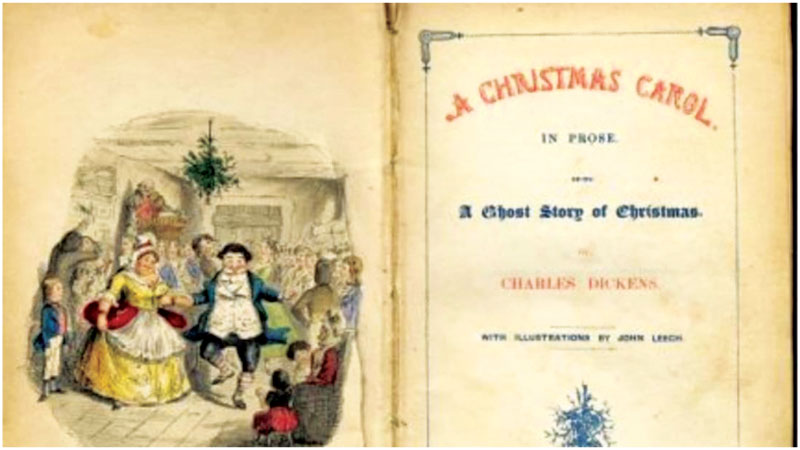As far back as the late 1950s, I had the chance to read a Sinhala translation of Charles Dickens’ A Christmas Carol, the celebrated novel that had charmed and inspired millions over the years. It is recorded that there have been scores of editions, translations, stage plays and films based on the narrative. As I remember, the Sinhala translation is titled Nattal Gitaya as delivered by well-known writer Cyril C Perera.
Dickens’ narrative is based on one of his own experiences as a dweller in a busy street in London. He had come to know of several misers living in the world of business who live for the sake of earning, money as much as possible. These businessmen are symbolised via a character named Scrooge. As a child, he knew quite a number of age-old Christmas fantasies, where the gods, angels as well as devils play a vital role capturing the good side as well as the evil side of human experiences. He felt that his narrative persona could be transformed into a person who realises the essence of the human standpoint. As such, he made the leading character named as cited, Ebenezer Scrooge, retire alone from the workplace of his cold barren apartment on the Christmas Eve. This miserly London businessman is shown as visited by a spirit of his dead partner in the business.
He is one Jacob Marley. He wants to know what Scrooge is up to in his ways. He comes to know that Scrooge is unkind to his fellow mates in the business. The miserly manners have made him too inhuman.
Illumination
Then Marley tries to transform Scrooge by way of an interlocution that looks more theatrical than mere description. Scrooge feels that he had been not only unkind but also insensitive to others around him due to his greed. The ghost warns Scrooge to change his behaviour pattern that keeps the narrative alive.
The moment of illumination is the fact that Scrooge undergoes a spiritual change that transcends a mere confession. Scrooge realises that he is a sinner by being a miser. Marley’s ghost claims that he had become a ghost as a result of being a close associate of Scrooge. This may perhaps remind a local Buddhist reader about the Pretas and the Bhootas of the dismal world of sufferers.
Dickens, I felt, is a creator who has awareness of the cross-cultural forms of spiritual communication. This is observed vita the scenes of the Christmas past, Christmas present and Christmas yet to come, appear as visuals in print. The novel, A Christmas Carol, depicts how Scrooge renounces his former selfishness and becomes a kind, generous and loving person who has learned the true spirit of Christmas.
Excitement
As Thomas J Burns, a Dickensian scholar writes in his learned essay Mr Dickens’ Famous Story, A Christmas Carol captured his heart and soul. It became a labour of love. Every time he dipped his quill pen into his ink, the characters seemed magical to take life.
Apart from the ghost and Scrooge, a few others like Tiny Tim with his crutches and Bob Crotchet drinking Christmas Cheer in the face of poverty. Those things happen while Scrooge encounters the ghost in fear and self-pity. According to Burns, each morning other resuming of writing the work, Dickens had grown a certain degree of excitement and impatience in the creative process. Dickens had later written to a newspaper: “I was very much affected by the little book,” and was reluctant to lay it aside even for a moment.
Message
John Foster, a biographer of Dickens, once said that Dickens had taken note of the strange mystery. The story embedded as a fantasy held over the creator Dickens in the writing process when he had even ‘wept, and laughed and wept again.” Dickens had never doubted that A Christmas Carol, a short narrative, would be popular. But neither he nor his publisher in London was ready for the overwhelming response that came.
It is recorded that the first edition of 6000 copies had sold out by Christmas Eve, and as the little book’s heart-warming message spread, Dickens later recalled he received by every post all manners of letters: about their homes and hearts and how the Carol is read aloud there and kept on a very little shelf by itself.
Dickens is regarded as the most popular English novelist of the 19th century. The Russian writer Fyodor Dostoevsky was highly influenced by the writings and creative thinking of Dickens. Some critics believe that the experimental creative process in Dickens led him to write A Christmas Carol. It is the strong autobiographical element that is observed in creative thinking.
A Christmas Carol is a narrative translated more than 18 languages around the world. It is believed that Dickens had popularised many aspects of the Christmas message and the spiritual essence through the work as celebrated around the world today, inclusive of family gatherings, charity services and gift-offerings. Even the very term ‘Merry Christmas’ is a result of this narrative it is used in the work.
Burns sums up:
“For Charles Dickens, a little Christmas narrative brought a newfound faith in himself and the redemptive joy of the season.”



Add new comment